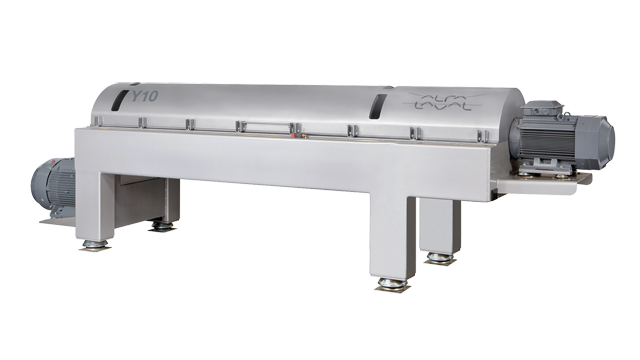Aceite de oliva - Serie Y
Specifically for two-phase operation, the Alfa Laval Olive Oil Y-series of decanter centrifuges is designed to provide cost-effective operation in the olive oil production chain: Clarification, extraction, dewatering and classification on first and second extraction.
Design features and benefits
The decanters feature a special design for two phase operation. The geometry of the conveyor allows a good performance through:
-
Open and gentle feed zone design “Esbjerg” able to give maximum performance and wear resistance
-
Special flight for oil migration to the liquid outlet able to optimize yield and oil clarification avoiding turbulence
-
Special conveyor design to improve solids transportation and liquid separation
-
Tungsten carbide tiles on conveyor forAlfa Laval Y9 and Alfa Laval Y10. Optional for Alfa Laval Y8. Special and exclusive wear protection able to significantly reduce maintenance cost of conveyor.
Through the electronic control of the conveyor speed (differential speed) the retention time can be adjusted and set to obtain the required degree of oil clarification. Electronic control of differential speed is done trough a variable frequency drive (VFD) directly connected to Alfa Laval's exclusive direct drive gearbox. This new setup makes it possible to reduce power consumption and wear due to transmission.
High quality stainless steel is used throughout, including hinged casings for easy opening, maintenance and cleaning.
The decanters also have an electronic overload protection system.
Cómo funciona
El diseño de la centrífuga decantadora garantiza la separación de la pasta de aceituna entrante en dos fases: aceite y sólidos húmedos.
La pasta de aceituna se introduce en el recipiente a través de un tubo de entrada estacionario y luego se acelera suavemente mediante un rotor de entrada. La separación tiene lugar en un recipiente cilíndrico horizontal equipado con un transportador de tornillo. La fuerza centrífuga provoca la sedimentación instantánea de los sólidos húmedos en la pared del recipiente.
El transportador gira en la misma dirección que la cuba, pero a una velocidad diferente, y transporta los sólidos húmedos al extremo cónico. Al ser más ligero, el aceite fluye por el interior y los sólidos húmedos se desplazan hacia el perímetro exterior. La separación tiene lugar a lo largo de toda la parte cilíndrica del recipiente. Las fases líquidas pasan a su salida a través de un filtro vibratorio y se descargan en tanques de recogida.

